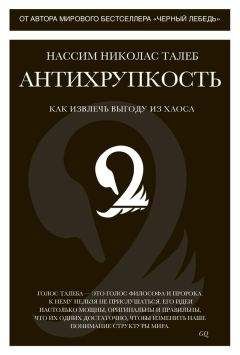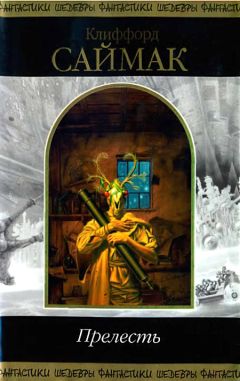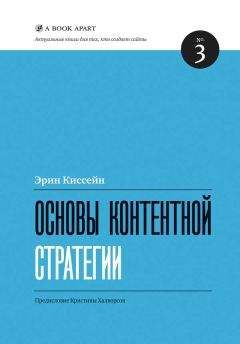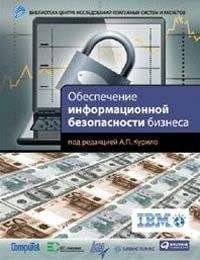Ознакомительная версия.
Deneubourg, J. L., J. M. Pasteels, and J. C. Verhaeghe, 1983, “Probabilistic Behavior in Ants: A Strategy of Errors?” Journal of Theoretical Biology 105: 259–271.
Derman, E., and N. N. Taleb, 2005, “The Illusions of Dynamic Replication.” Quantitative Finance 5: 4.
Dhabhar, F. S., 2009, “Enhancing Versus Suppressive Effects of Stress on Immune Function: Implications for Immunoprotection and Immunopathology.” Neuroimmunomodulation 16 (5): 300–317.
Dhabhar, F. S., A. N. Saul, C. Daugherty, T. H. Holmes, D. M. Bouley, T. M. Oberyszyn, 2010, “Short-term Stress Enhances Cellular Immunity and Increases Early Resistance to Squamous Cell carcinoma.” Brain, Behavior and Immunity 24 (1): 127–137.
Dhabhar, F. S., A. N. Saul, T. H. Holmes, C. Daugherty, E. Neri, J. M. Tillie, D. Kusewitt, T. M. Oberyszyn, 2012, “High-Anxious Individuals Show Increased Chronic Stress Burden, Decreased Protective Immunity, and Increased Cancer Progression in a Mouse Model of Squamous Cell Carcinoma.” PLOS ONE 7 (4): e33069.
Diamond, Jared, 1988, “Why Cats Have Nine Lives.” Nature, Vol. 332, April 14.
Dixit, A. K. and R. S. Pindyck, 1994, Investment Under Uncertainty. Princeton, N.J.: Princeton University Press.
Djebbar, Ahmed, 2001, Une histoire de la science arabe. E2ditions du Seuil.
Dook, J. E., C. James, N. K. Henderson, and R. I. Price, 1997, “Exercise and Bone Mineral Density in Mature Female Athletes.” Medicine and Science in Sports and Exercise 29 (3): 291–296.
Douady, R. and N. N. Taleb, 2011, “Statistical Undecidability,” preprint.
Driver, P. M., and D. A. Humphries, 1988, Protean Behaviour: The Biology of Unpredictability. Oxford: Oxford University Press.
Duffin, Jacalyn, 1999, History of Medicine: A Scandalously Short Introduction. Toronto: University of Toronto Press.
Dunne, J. A., R. J. Williams, et al., 2002, “Network Topology and Biodiversity Loss in Food Webs: Robustness Increases with Connectance.” Ecology Letters 5 (4): 558–567.
Earle, J., 1975, “Thyroid Cancer. Delayed Effects of Head and Neck Irradiation in Children (Medical Information).” Western Journal of Medicine 123: 340, October.
Easterly, W., 2001, The Elusive Quest for Growth: Economists’ Adventures and Misadventures in the Tropics. Cambridge, Mass.: The MIT Press.
Easterly, W., and A. Kraay, 2000, “Small States, Small Problems? Income, Growth, and Volatility in Small States.” World Development 28 (11): 2013–2027.
Easterly, W., M. Kremer, L. Pritchett, and L. Summers, 1993, “Good Policy or Good Luck? Country Growth Performance and Temporary Shocks” Journal of Monetary Economics 32 (3): 459–483.
Easterly, William, 2006, The White Man’s Burden: Why the West’s Efforts to Aid the Rest Have Done So Much Ill and So Little Good. Penguin Group.
Eberhard, Wolfram, 1950, 1977, A History of China. University of California Press.
Edelstein, Ludwig, 1987, Ancient Medicine. Johns Hopkins University Press.
Edgerton, David, 1996a, “The ‘White Heat’ Revisited: British Government and Technology in the 1960s.” Twentieth Century British History 7 (1): 53–82.
Edgerton, David, 1996b, Science, Technology, and the British Industrial ‘Decline,’ 1870–1970. Cambridge: Cambridge University Press.
Edgerton, David, 2004, “The ‘Linear Model’ Did Not Exist: Reflections on the History and Historiography of Science and Research in Industry in the Twentieth Century.” In Karl Grandin and Nina Wormbs, eds., The Science – Industry Nexus: History, Policy, Implications. New York: Watson.
Edgerton, David, 2007, The Shock of the Old: Technology and Global History Since 1900, Oxford.
Ekern, S., 1980, “Increasing Nth Degree Risk.” Economics Letters 6 (4): 329–333.
Elkington, John, and Pamela Hartigan, 2008, The Power of Unreasonable People: How Social Entrepreneurs Create Markets That Change the World. Cambridge, Mass.: Harvard Business Press.
Emer, J., 2009, “An Evolution of General Purpose Processing: Reconfigurable Logic Computing.” Proceedings of the 7th Annual IEEE/ACM International Symposium.
Esnault, Y., 2001, “Francois Jacob, l’éloge du bricolage.” Biofutur (213).
Fabrizio, P., F. Pozza, S. Pletcher, C. Gendron, and V. Longo, 2001, “Regulation of Longevity and Stress Resistance by Sch9 in Yeast.” Science’s STKE 292 (5515): 288.
FejtÖ, François, 1989, Requiem pour un Empire défunt. Histoire de la destruction de l’Autriche-Hongrie. Paris: Lieu Commun.
Ferguson, Niall, 2011, Civilization: The West and the Rest. Penguin.
Fernandez, G., E. S. Spatz, C. Jablecki, P. S. Phillips, 2011, “Statin Myopathy: A Common Dilemma Not Reflected in Clinical Trials.” Cleveland Clinic Journal of Medicine 78 (6): 393–403.
Ferrante, Louis, 2011, Mob Rules: What the Mafia Can Teach the Legitimate Businessman. Penguin.
Finch, C., V. Longo, A. Miyao, T. Morgan, I. Rozovsky, Y. Soong, M. Wei, Z. Xie, and H. Zanjani, 2001, “Inflammation in Alzheimer’s Disease.” In M. – F. Chesselet, ed., Molecular Mechanisms of Neurodegenerative Diseases, pp. 87–110.
Fink, W., V. Lipatov, et al., 2009, “Diagnoses by General Practitioners: Accuracy and Reliability.” International Journal of Forecasting 25 (4): 784–793.
Finley, M. I., 1953, “Land, Debt, and the Man of Property in Classical Athens.” Political Science Quarterly 68 (2): 249–268.
Flyvbjerg, Bent, 2001, Making Social Science Matter: Why Social Inquiry Fails and How It Can Succeed Again. Cambridge: Cambridge University Press.
Flyvbjerg, Bent, and Alexander Budzier, 2011, “Are You Sitting on a Ticking Time Bomb?” Harvard Business Review, September.
Flyvbjerg, Bent, 2009, “Survival of the Unfittest: Why the Worst Infrastructure Gets Built – and What We Can Do About It.” Oxford Review of Economic Policy, Vol. 25, No. 3, 344–367.
Fossedal, G. A., and A. R. Berkeley III, 2005, Direct Democracy in Switzerland. Transaction Pub.
Fourest, Caroline, and Fiametta Venner, 2010, Les interdits religieux. Éditions Dalloz.
Franklin, James, 2001, The Science of Conjecture: Evidence and Probability Before Pascal. Baltimore: Johns Hopkins University Press.
Freedman, D. A., and D. B. Petitti, 2001, “Salt and Blood Pressure: Conventional Wisdom Reconsidered.” Evaluation Review 25 (3): 267–287.
Freedman, D., D. Collier, et al., 2010, Statistical Models and Causal Inference: A Dialogue with the Social Sciences. Cambridge: Cambridge University Press.
Freeman, C., and L. Soete, 1997, The Economics of Industrial Innovation. London: Routledge.
Freidson, Eliot, 1970, Profession of Medicine: A Study of the Sociology of Applied Knowledge. Chicago: University of Chicago Press.
French, Roger, 2003, Medicine Before Science: The Rational and Learned Doctor from the Middle Ages to the Enlightenment. Cambridge: Cambridge University Press.
Froot, K. A., 2001, “The Market for Catastrophe Risk: A Clinical Examination,” Journal of Financial Economics 60 (2–3): 529–571.
Fujiwara, Y., 2004, “Zipf Law in Firms Bankruptcy.” Physica A: Statistical and Theoretical Physics 337: 219–30.
Fukumoto, S., and T. J. Martin, 2009, “Bone as an Endocrine Organ.” Trends in Endocrinology and Metabolism 20: 230–236.
Fuller, Steve, 2005, The Intellectual. Icon Books.
GarcĆa-Ballester, Luis, 1995, “Health and Medical Care in Medieval Galenism.” In Don Bates, ed., Knowledge and the Scholarly Medical Traditions. Cambridge: Cambridge University Press.
Garland, Robert, 1998, Daily Life of the Ancient Greeks. Indianapolis: Hackett.
Gauch, Ronald R., 2009, It’s Great! Oops, No It Isn’t: Why Clinical Research Can’t Guarantee the Right Medical Answers. Springer.
Gawande, Atul, 2002, Complications: A Surgeon’s Note on an Imperfect Science. Picador.
Geach, Peter, 1966, “Plato’s Euthyphro,” The Monist 50: 369–382.
Geison, Gerald L., 1995, The Private Science of Louis Pasteur. Princeton, N.J.: Princeton University Press.
Gems, D., and L. Partridge, 2008, “Stress-Response Hormesis and Aging: That Which Does Not Kill Us Makes Us Stronger.” Cell Metabolism 7 (3): 200–203.
Gibbert, M. and P. Scranton, 2009, “Constraints as Sources of Radical Innovation? Insights from Jet Propulsion Development.” Management & Organizational History 4 (4): 385.
Gigerenzer, Gerd, 2008, “Why Heuristics Work.” Perspectives on Psychological Science 3 (1): 20–29.
Gigerenzer, Gerd, and H. Brighton, 2009, “Homo heuristicus: Why Biased Minds Make Better Inferences.” Topics in Cognitive Science 1 (1): 107–143.
Gigerenzer, Gerd, and W. Gaissmaier, 2011, “Heuristic Decision Making.” Annual Review of Psychology 62: 451–482.
Gladwell, Malcolm, 2009, What the Dog Saw: And Other Adventures. Hachette Group.
Glaeser, E., 2011, Triumph of the City: How Our Greatest Invention Makes Us Richer, Smarter, Greener, Healthier, and Happier. New York: Penguin
Glaser, Scott, and Rinoo Shah, 2010, “Root Cause Analysis of Paraplegia Following Transforaminal Epidural Steroid Injections.” Pain Physician 13: 237–244.
Gold, Rich, 2007, The Plenitude: Creativity, Innovation, and Making Stuff. Cambridge, Mass.: The MIT Press.
Goldacre, B., 2007, “Benefits and Risks of Homoeopathy.” Lancet 370 (9600): 1672–1673.
Goldacre, B., 2009, Bad Science: Quacks, Hacks, and Big Pharme Flacks. London: Harper Perennial.
Goldstein, D. G., and G. Gigerenzer, 1999, “The Recognition Heuristic: How Ignorance Makes Us Smart.”
Goldstein, D. G., and G. Gigerenzer, 2002, “Models of Ecological Rationality: The Recognition Heuristic.” Psychological Review 109 (1): 75.
Goldstein, D. G., and N. N. Taleb, 2007, “We Don’t Quite Know What We Are Talking About When We Talk About Volatility,” Journal of Portfolio Management, Summer.
Gott, J. Richard III, 1993, “Implications of the Copernican Principle for Our Future Prospects.” Nature 363 (6427): 315–319.
Gott, J. Richard III, 1994, “Future Prospects Discussed.” Nature 368: 108.
Graeber, David, 2011, Debt: The First 5000 Years. Melville House Publishing.
Graham, M. R., C. J. Haberman, et al., 2005, “Mathematical Modelling to Centre Low Tidal Volumes Following Acute Lung Injury: A Study with Biologically Variable Ventilation.” Respiratory Research 6 (1): 64.
Granger, Clive W. J., 1999, Empirical Modeling in Economics: Specification and Evaluation. Cambridge: Cambridge University Press.
Grant, Ruth W., 2011, Strings Attached: Untangling the Ethics of Incentives. Princeton, N.J.: Princeton University Press.
Graver, M., 2007, Stoicism and Emotion. Chicago: University of Chicago Press.
Gray, John, 1998, Hayek on Liberty. Psychology Press.
Gray, John, 2002, Straw Dogs: Thoughts on Humans and Other Animals. London: Granta Books.
Gray, John, 2011, The Immortalization Commission: Science and the Strange Quest to Cheat Death. Allen Lane.
Greenwood, R., and R. Suddaby, 2006, “The Case of Disappearing Firms: Death or Deliverance?” Journal of Organizational Behavior 27 (1): 101–108.
Grice, E. A., and J. A. Segre, 2011, “The Skin Microbiome.” Nature Reviews Microbiology 9 (4): 244–253.
Griffith, S. C., I.P.F. Owens, and K. A. Thuman, 2002, “Extrapair Paternity in Birds: A Review of Interspecific Variation and Adaptive Function.” Molecular Ecology 11: 2195–212.
Grob, Gerald N., 2002, The Deadly Truth: A History of Disease in America. Cambridge, Mass.: Harvard University Press.
Guadalupe-Grau, A., T. Fuentes, B. Guerra, and J. Calbet, 2009, “Exercise and Bone Mass in Adults.” Sports Medicine 39 (6): 439–468.
Guarner, F., R. Bourdet-Sicard, et al., 2006, “Mechanisms of Disease: the Hygiene Hypothesis Revisited.” Nature Clinical Practice Gastroenterology & Hepatology 3 (5): 275–284.
Guidone, C., et al., 2006, “Mechanisms of Recovery from Type 2 Diabetes After Malabsorptive Bariatric Surgery.” Diabetes 55: 2025–2031.
Hacking, Ian, 1984, The Emergence of Probability: A Philosophical Study of Early Ideas About Probability, Induction and Statistical Inference. Cambridge: Cambridge University Press.
Hacking, Ian, 1990, The Taming of Chance. Cambridge: Cambridge University Press.
Hacking, Ian, 2006, The Emergence of Probability, 2nd ed. New York: Cambridge University Press.
Hadler, Nortin M., M.D., 2008, Worried Sick: A Prescription for Health in an Overtreated America. Chapel Hill: University of North Carolina Press.
Hadler, Nortin M., M.D., 2009, Stabbed in the Back. Chapel Hill: University of North Carolina Press.
Haidt, J., 2012, The Righteous Mind: Why Good People Are Divided by Politics and Religion. New York: Pantheon.
Haigh, J., 2000, “The Kelly Criterion and Bet Comparisons in Spread Betting.” Journal of the Royal Statistical Society: Series D (The Statistician) 49 (4): 531–539.
Hajek, A., 2003, Interpretations of Probability. Citeseer.
Halagappa, V.K.M., Z. Guo, et al., 2007, “Intermittent Fasting and Caloric Restriction Ameliorate Age-Related Behavioral Deficits in the Triple-Transgenic Mouse Model of Alzheimer’s Disease.” Neurobiology of Disease 26 (1).
Hald, Anders, 1998, A History of Mathematical Statistics from 1750 to 1930. New York: Wiley.
Hald, Anders, 2003, A History of Probability and Statistics and Their Applications Before 1750. Hoboken, N.J.: Wiley.
Ознакомительная версия.




